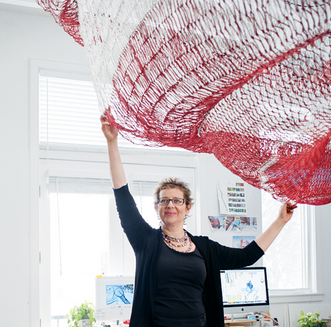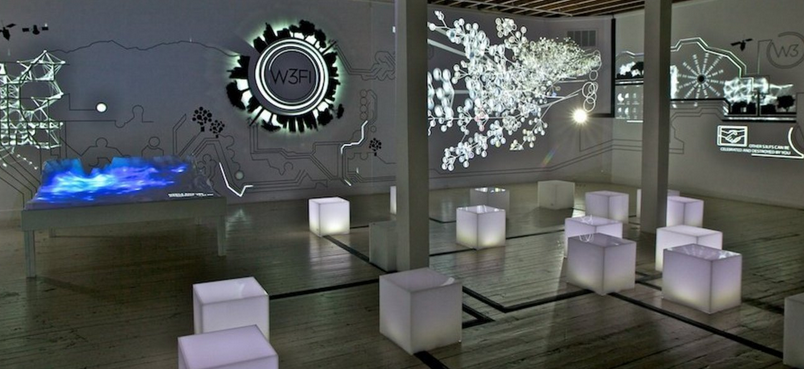Focusing on the conference presentations, it is important to pay much attention to Day 2 of the Academic Conference (4 November 2014). During that day, speakers focused on the discussion of the smart city of the future. Moreover, the reason is that the keynote address was provided by Janet Echelman. Thus, Janet Echelman is the American artist and sculptor who creates lightweight sculptures connected with buildings that can move and change depending on the forces of wind, water, and light.
While focusing on discussing the role of sculptures in cities, it was interesting to listen to Echelman’s presentation because the sculptor accentuated different aspects of creating soft urban sculptures. According to Echelman, the focus on hidden ideas is the key to creating innovative things. The artist uses modern technologies to create permanent sculptures that can move and change and respond to the idea of softness. Echelman states that such sculptures can change the space of cities of the future and make them zones for calmness. She emphasises the necessity to avoid acute edges in her works.
Exhibition Tour
Visiting the Zayed University Dubai Convention Centre, viewers see the variety of installations in which modern technologies are used in a creative manner. The high-tech installations seem to be lively and impressing. In this context, W3FI is the most inspiring work because it impresses with its scale and format which resembles ‘clouds’ and virtual ‘bubbles’. W3FI discusses the idea of the interaction in the networks. Thus, it is interesting to pay attention to studying techniques associated with projections and animations in order to make stable artworks changing, moving, and meaningful, as it is in W3FI. Messages in W3FI reflect the authors’ considerations on the topic.
Discussion of Three Artists, Speakers, or Artworks
Janet Echelman
Janet Echelman’s soft and changing sculptures are the combination of the craftwork and modern technologies. Thus, Echelman’s works made of fibres are weightless and moving under the impact of the water and wind. They are colourful and changing. It is important to focus on Echelman’s works because the sculptor follows the philosophy of making city spaces more appropriate for dreaming without adding more edges or strict lines to buildings (Picture 1). From this point, Echelman’s light colourful sculptures resemble waves in the city’s skies. It seems that the sculptor uses simple techniques to make the monumental sculpture, and it becomes light and moving in spite of its permanency.

Laleh Mehran and Christopher Coleman
Laleh Mehran and Christopher Coleman are artists who work independently and often collaborate to create the art works with the help of innovative technologies (Picture 2). Technology, innovation, interaction, and motion are key elements of the artists’ work. It is important to discuss these artists’ approaches because their works reflect recent tendencies in the modern social and technological world. Mehran and Coleman use latest technologies and computer programmes to create their art works and installations. To understand how other modern artists utilise innovative technologies, it is necessary to discuss the works by Mehran and Coleman first.

W3FI: Dubai
W3FI is an interactive installation that presents how the diverse population of Dubai interacts with the help of modern computer technologies. The authors of the artwork focus on the role of the person’s digital image represented in the idea of ‘selfie’. The work needs to be discussed because it covers the important topic of the role of IT in the social life (Picture 3). The installation attracts attention because it is made with the help of several projections which create animations at walls to accentuate the idea of the constant virtual interaction with the focus on digital selves.

Overall Reflection
ISEA 2014 Location, a symposium conducted in the United Arab Emirates, is an impressing event that makes speakers and participants create a new vision of the connection between art and technology. I understand the mission of ISEA 2014 as the creation of links between the idea of location, role of technologies, and development of new perspectives. ‘Location’ is a main theme discussed during the symposium in different contexts. I should state that this theme is effective to reflect current tendencies not only in the UAE art but also in the global art, focused on using new scientific and technological innovations.
If the discussion of the connection between science, technologies, and art is typical for different symposiums, ISEA 2014 impresses with the focus on using social media and information technologies in creating art works that reflect the current trends in the world. The most interesting parts of the programme are the discussion of the combination of technologies and natural objects and lines; the discussion of the digital sculpture and animation; and the discussion of the role of the interactive art in the world.
This symposium stimulates to learn more on how artists and sculptors can use technologies to accentuate the natural beauty of objects in the urban context. Thus, focusing on the experience of Janet Echelman, it is possible to review the approach to discussing the stability of spaces and locations as well as the association between the nature and technologies. I am also interested in learning more about animation and the digital sculpture as the new approach to convey artistic ideas in a way understandable for people who spend a lot of time while using technologies and interacting online.
Therefore, I selected to pay more attention to the work by Laleh Mehran and Christopher Coleman known as W3FI: Dubai. There are many people in the UAE and round the globe who use social media and Internet without concentrating on the idea that they create a new digital image of selves. No information can be discussed as private in the era of modern technologies. This art installation is attractive because it covers urgent and current topics and ideas and because of the authors’ unique approach to presenting the virtual world in a form of the real network. The most exciting moment for me is the understanding of how the authors choose to discuss the problem of the ‘individual’ and ‘social’ in their work. This opposition is also reflected in many other speakers’ notes and conference discussions.
It is a unique experience to observe how artists combine the world of technology and such modern concepts as ‘social media’ in order to support their deep philosophical visions and ideas. I am interested in similar exhibitions because they provide the creative reflection of the modern tendencies covering not only the world of art but also the real world rounds us. From this point, visiting exhibitions and examining the works of the modern artists, it is possible to understand the paths of the art development today.